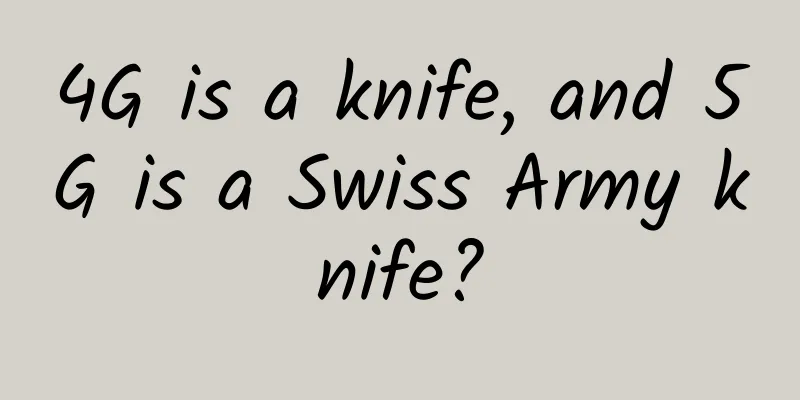4G is a knife, and 5G is a Swiss Army knife?

|
If the 4G network is a knife that can cut iron like mud and cut hair like a blade, then the 5G network is a Swiss Army knife that is flexible, convenient and multifunctional. 4G networks are mainly designed for smartphones. Entering the 5G era, we will face the "next big thing" - the Internet of Things. In the era of everything being connected, a large number of devices will be connected to the network. These devices belong to different industrial fields and have different characteristics and requirements. In other words, they have different requirements for network mobility, security, latency, reliability, and even billing methods. Therefore, the 5G network must be as flexible, convenient and multifunctional as a Swiss Army knife. Let me give you two examples. In IoT applications for forest fire prevention, a large number of sensors distributed in the forest detect temperature, humidity and precipitation. They are stationary and do not require mobility management such as switching and location updates like smartphones. A NOKIA report shows that it is expected that 70% of devices in 5G networks will be stationary, while mobile users will only account for 30%. When 5G is applied to fields such as unmanned driving and remote robot control, ultra-low end-to-end latency is required. This latency is much lower than the latency of wireless Internet access on smartphones and usually cannot exceed a few milliseconds. Therefore, for different application areas, the 5G network must be like a Swiss Army knife. What to do? When the whole world is talking about 5G, the most talked about thing in the communications industry is 5G network slicing technology. Network slicing has become the most ideal 5G network architecture recognized by China Mobile, South Korea's KT, SK Telecom, Japan's KDDI and NTT, as well as equipment manufacturers such as Ericsson, Nokia, and Huawei. What is network slicing? The simplest understanding is to cut a physical network into multiple virtual end-to-end networks. Each virtual network, including the devices, access, transmission and core networks within the network, is logically independent. A failure in any virtual network will not affect other virtual networks. Each virtual network is like the pliers and saws on a Swiss Army knife, with different functional characteristics and facing different needs and services. Or you can say that it is like when you install your computer, you partition your physical hard disk into C drive, D drive, E drive... To further understand 5G network slicing, we first divide the application scenarios of 5G networks into three categories: mobile broadband, massive IoT, and mission-critical IoT. As shown in the table above, the service requirements of the three application scenarios of 5G networks are different: 1) Mobile broadband The 5G era will be oriented towards applications such as 4K/8K ultra-high-definition video, holographic technology, augmented reality/virtual reality, and the main demand for mobile broadband is higher data capacity. 2) Massive Internet of Things Massive sensors are deployed in measurement, construction, agriculture, logistics, smart cities, homes and other fields. These sensor devices are very dense and most of them are stationary. 3) Mission-critical IoT Mission-critical IoT is mainly used in areas such as unmanned driving, automated factories, and smart grids, and the main requirements are ultra-low latency and high reliability. The 4G network mainly serves people, and the main device connecting to the network is a smartphone. There is no need for network slicing to cater to different application scenarios. In the 5G era, a large number of different devices in different fields will be connected to the network, and the network will be oriented towards three application scenarios: mobile broadband, massive Internet of Things, and mission-critical Internet of Things. How to slice the network? We don't need to build a network for each application scenario, so it's not like this... What we need to do is to divide a physical network into multiple virtual logical networks, each of which corresponds to a different application scenario. This is called network slicing. The architecture of network slicing in the 5G white paper is as follows: How will we complete end-to-end network slicing? The above content is too abstract. How do we do it in actual network deployment? 1) 5G radio access network and core network: NFV Currently, the main terminal devices in 4G networks are mobile phones. The wireless access network part (including digital units (DU) and radio frequency units (RU)) and the core network part of the network all use dedicated equipment provided by equipment manufacturers. As shown below: In order to realize network slicing, Network Function Virtualization (NFV) is a prerequisite. In essence, NFV is to transfer the software and hardware functions of dedicated devices in the network (such as MME, S/P-GW and PCRF in the core network, digital unit DU in the wireless access network, etc.) to virtual hosts (VMs, Virtual Machines). These virtual hosts are based on industry-standard commercial servers. They are COTS commercial off-the-shelf products, low-cost and easy to install. Simply put, it is to replace the dedicated network element devices in the network with industry-standard servers, storage and network devices. After the network is virtualized, the wireless access network is called the edge cloud, and the core network is called the core cloud. The VMs in the edge cloud and the VMs in the core cloud are interconnected through SDN (software defined network). In this way, after the network adopts NFV and SDN, it is very easy to perform slicing. Just "cut" the network horizontally into multiple virtual sub-networks (slices) like cutting bread. As shown in the figure above, the network is "cut" into four "slices" for different application scenarios: HD video slicing: The original digital unit (DU) and some core network functions in the network are virtualized, and then put into the edge cloud together with the storage server. Some virtualized core network functions are put into the core cloud. Mobile slicing: The digital unit (DU) of the original network's wireless access part is virtualized and placed in the edge cloud. The core network functions of the original network, including IMS, are virtualized and placed in the core cloud. Massive IoT slice: Since most sensors are stationary and do not require mobility management, the core cloud's tasks in this slice are relatively easy and simple. Mission-critical IoT slicing: Due to the high latency requirements, in order to minimize end-to-end latency, the core network functions and related servers of the original network are moved to the edge cloud. The network structure is as follows: Of course, network slicing technology is not limited to these types of slices. It is flexible, and operators can customize their own virtual networks according to application scenarios at will. 2) Connection between edge cloud and core cloud: IP/MPLS-SDN The 5G slice network connects the VMs in the edge cloud and the core cloud through SDN. The core cloud has virtualized servers, and the server's Hypervisor runs a built-in vRouter/vSwitch. The SDN controller is responsible for creating SDN tunnels between the virtual servers and the DC G/W routers. Subsequently, the SDN controller performs the mapping between the SDN tunnels and the MPLS L3 VPN to establish the connection between the core cloud and the edge cloud. 3) Network slicing of edge cloud and base station radio frequency unit Now, let's move to the fronthaul part. How to complete the slicing between the 5G radio unit (RU) and the edge cloud (fronthaul)? First, we need to define the standard for 5G fronthaul, but there is no unified standard at present. The following figure is a structure diagram of a virtualized fronthaul proposed by the International Telecommunication Union (ITU) 5G Mobile Communication Standards Research Group (Focus Group on IMT-2020). If you are interested, you can take a look: This is the 5G network slicing technology. With it, 5G will become a sharp Swiss Army knife in the field of wireless networks. |
Recommend
Huawei Cloud Managed Campus Solution Accelerates Enterprise Digital Transformation by Saving OPEX by 87% in Three Years
[51CTO.com original article] In the digital age, ...
Tencent Cloud launches Supermind intelligent network to accelerate global network with cloud as the core
[51CTO.com original article] The application of i...
6G network speed greatly improved, Chinese team set a new record of terahertz 100Gbps transmission
5G network technology has increased the speed of ...
DesiVPS: $3/month-2GB/20G SSD/2.5TB/San Jose & Netherlands Data Center
DesiVPS is an Indian VPS hosting provider headqua...
HostYun Los Angeles CU2 (AS9929) VPS simple test
I looked through the previous articles and found ...
15,000 Stars! Programmer's "Internet Swiss Army Knife"!
Introduction CyberChef is a web application for e...
Should I switch to a Wi-Fi 6 router as the holidays approach?
If 2019 is the first year of Wi-Fi 6 commercializ...
my country's optical chip technology upgrades accelerate the proportion of optical devices to rise year by year
Optical chips and optical components are the basi...
iONcloud 50% off annual payment $81/year - dual core/2G memory/60G SSD/3TB monthly traffic, Los Angeles/San Jose/Dallas/Honolulu data center
iONcloud under Krypt currently offers a 50% disco...
On the first day after Double Eleven, I heard that programmers all went here to "carnival"...
November 12, 2017, 2:00 p.m. The autumn is crisp,...
Even monkeys can penetrate the intranet!
Hello, everyone, I am amazing. I recently turned ...
How to solve the TCP packet sticking and unpacking problem when using Netty communication? The answer is so simple
[[311931]] This article will explain the followin...
Learn about the last of the four types of switch messages in one minute: known unicast
Continuing from the previous article "Learn ...
Major opportunities and challenges of 400G Ethernet
400G Ethernet is here. It is certified by the IEE...









